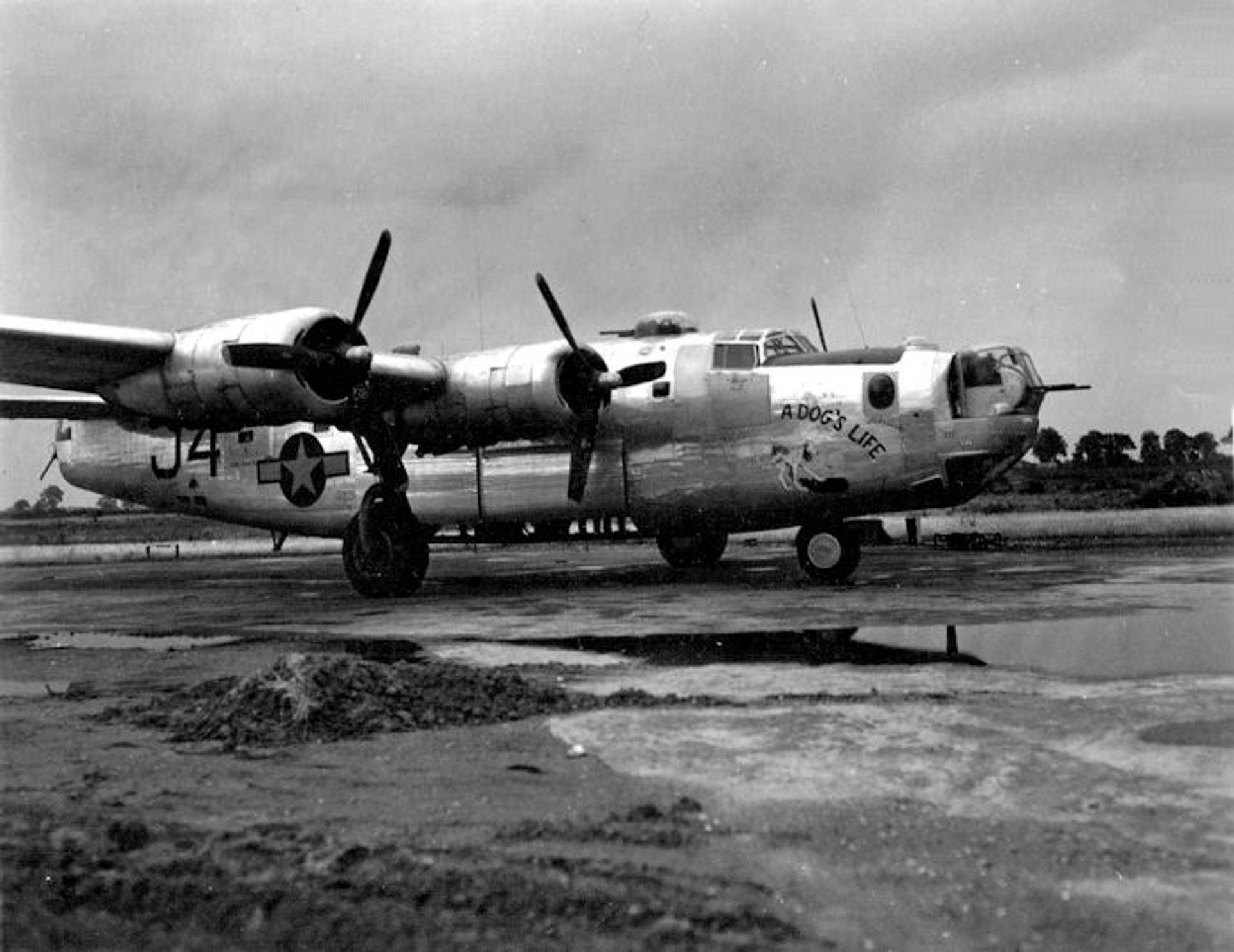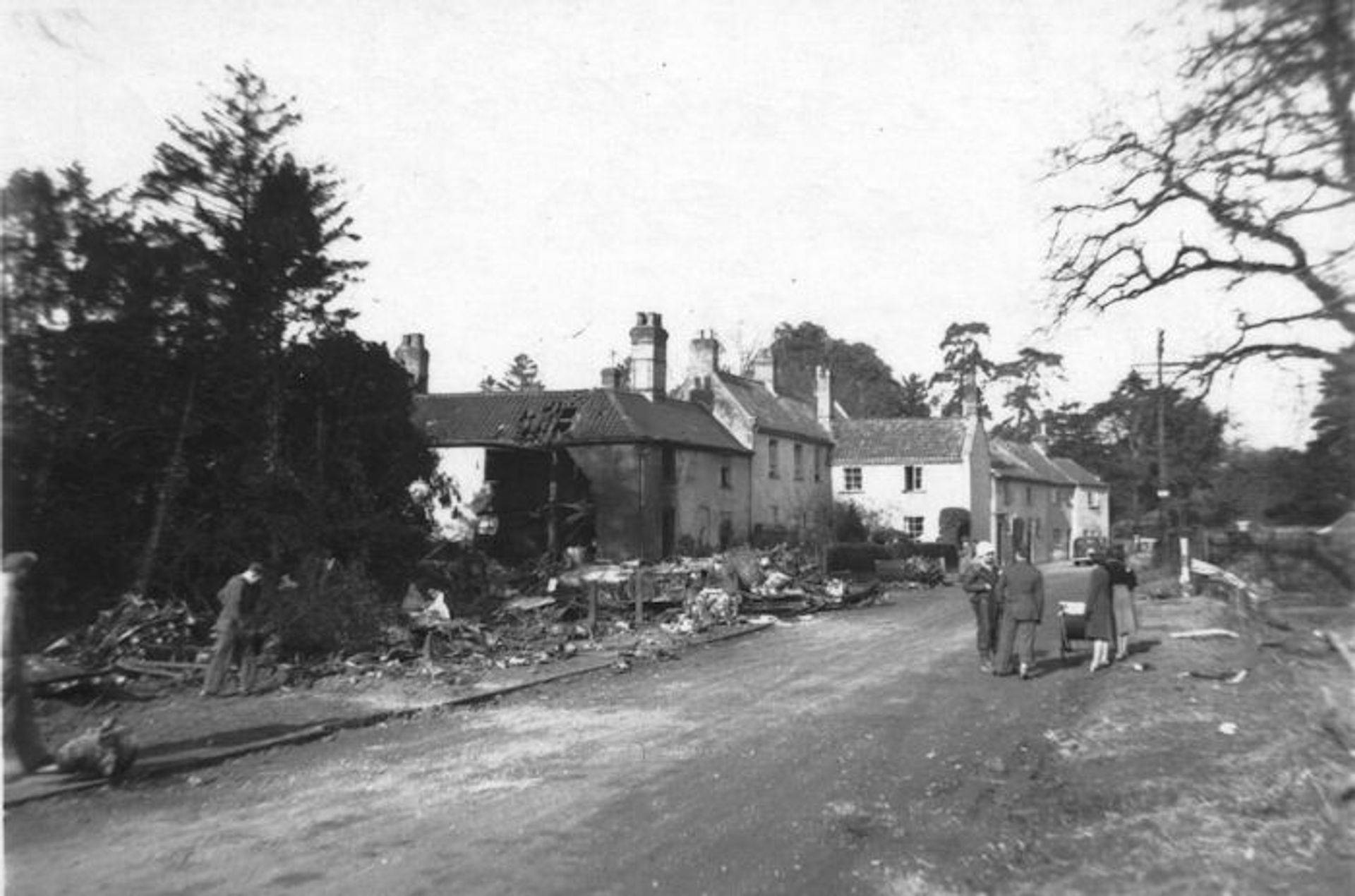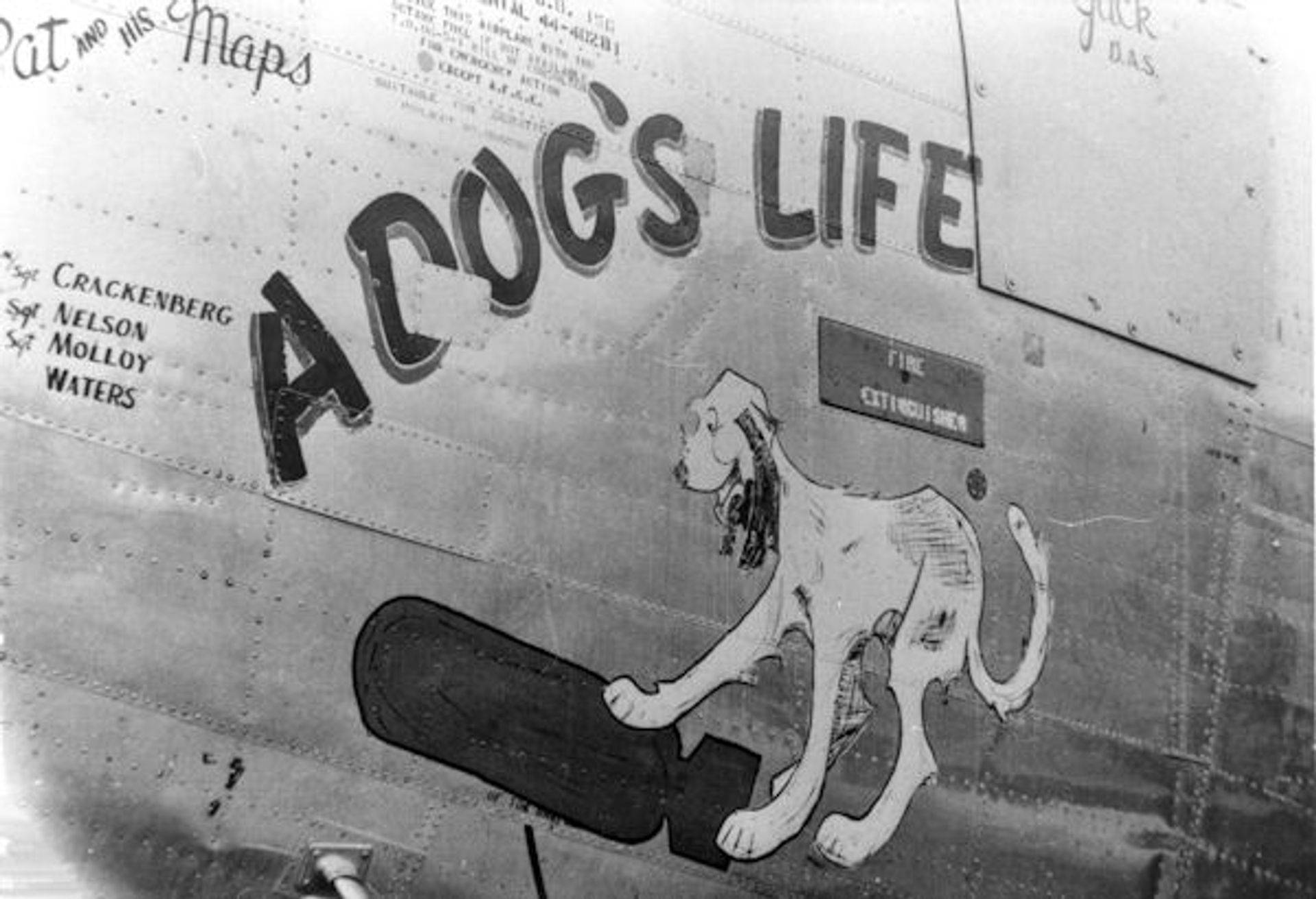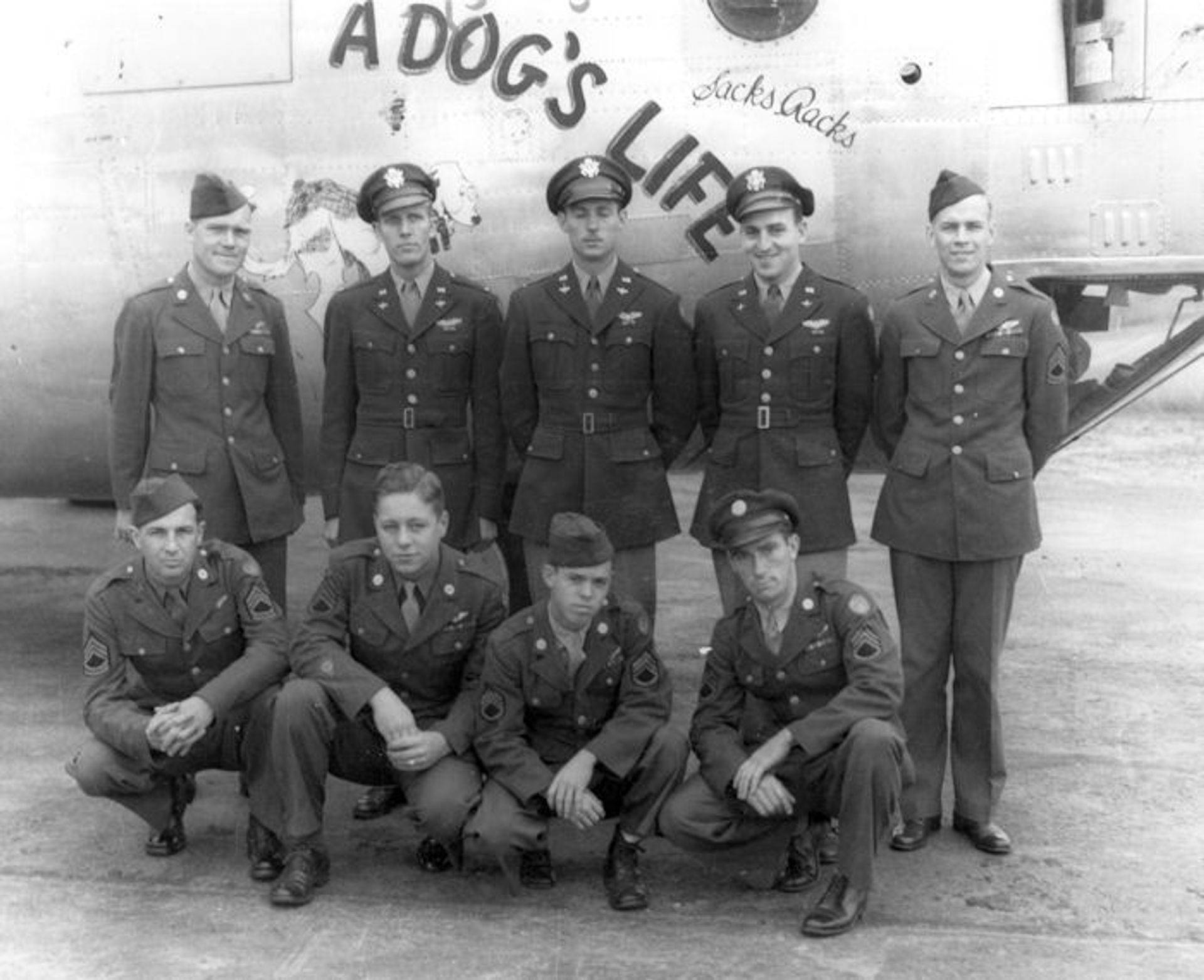458th Bombardment Group (H)
A Dog’s Life
B-24JAZ-155-CO 44-40281 J4 Q

A Dog’s Life was an original AZON ship and arrived in the 753rd Squadron in May 1944
(Photo: Mike Bailey)
Crash in Old Catton February 13, 1945 – AR 45-2-13-529
One of the original AZON ships flown to the ETO by 2Lt John I. Larned, this aircraft had a fairly long tenure with the 458BG. A Dog’s Life amassed 34 combat missions, including six AZON sorties in the nine months it was at Horsham St. Faith. It remained in the 753BS for this entire time. A close call collision over enemy territory in August 1944 almost spelled the end for this aircraft, but the skill of the pilot brought them back to base. The aircraft finally met its end on a practice mission on February 13, 1945 with the loss of 2Lt Lawrence R. Shannon and eight of his crew.
Missions
| Date | Target | Pilot | 458th Msn | Pilot Msn | Cmd Pilot | Ld | RCL | Sqdn | A/C Msn | Comments |
|---|---|---|---|---|---|---|---|---|---|---|
| 31-May-44 | 5 BRIDGES | LARNED | AZ01 | 1 | Q | J4 | 1 | |||
| 04-Jun-44 | 2 TACTICAL TARGETS | LARNED | AZ03 | 2 | Q | J4 | 2 | BOMB RACK MALFUNCTION | ||
| 08-Jun-44 | UNSPECIFIED TARGETS | LARNED | AZ04 | -- | Q | J4 | -- | ABANDONED - WEATHER | ||
| 14-Jun-44 | 5 TARGETS | LARNED | AZ06 | 3 | Q | J4 | 3 | |||
| 15-Jun-44 | 3 RAILWAY BRIDGES | LARNED | AZ07 | 4 | Q | J4 | 4 | |||
| 22-Jun-44 | Saumer, Tours - Tact Bridges | LARNED | AZ09 | 5 | Q | J4 | 5 | |||
| 20-Jul-44 | EISENACH | MANKER | 95 | 25 | Q | J4 | 6 | |||
| 24-Jul-44 | ST. LO AREA | MATZE | 97 | 8 | Q | J4 | 7 | |||
| 01-Aug-44 | T.O.s FRANCE | EVANS | 100 | 11 | Q | J4 | 8 | |||
| 04-Aug-44 | ACHIET A/F | BROWN, W | 104 | 10 | Q | J4 | 9 | |||
| 06-Aug-44 | HAMBURG | EVANS | 106 | 12 | Q | J4 | 10 | |||
| 09-Aug-44 | SAARBRUCKEN | EVANS | 109 | 13 | WRIGHT | L2 | Q | J4 | 11 | |
| 15-Aug-44 | VECHTA | EVANS | 114 | ABT | Q | J4 | -- | ABORT - ALL 4 GENERATORS FAILED | ||
| 17-Aug-44 | LE FOULONS RR BRIDGE | VINCENT | AZ11 | 3 | Q | J4 | 12 | 10/10 CLOUD - NO DROP - SORTIE CRED | ||
| 18-Aug-44 | WOIPPY | EVANS | 116 | 15 | SCHWARTZ | L1 | Q | J4 | -- | COLLISION WITH DEPUTY LEAD |
| 14-Oct-44 | COLOGNE | EVANS | 133 | 20 | BOOTH | L | Q | J4 | 13 | |
| 02-Nov-44 | BIELEFELD | McCARTHY | 140 | 29 | Q | J4 | 14 | |||
| 06-Nov-44 | MINDEN | WARRELL | 143 | 6 | Q | J4 | 15 | |||
| 08-Nov-44 | RHEINE | WARRELL | 144 | 7 | Q | J4 | 16 | |||
| 16-Nov-44 | ESCHWEILER | HOOD | 147 | 10 | Q | J4 | 17 | |||
| 25-Nov-44 | BINGEN | SEALY | 149 | ABT | Q | J4 | -- | ABORT - #1 ENG OIL LEAK | ||
| 26-Nov-44 | BIELEFELD | WARRELL | 150 | ABT | Q | J4 | -- | ABORT - #1, 4 ENG THOWING OIL | ||
| 06-Dec-44 | BIELEFELD | HADDEN | 153 | 9 | Q | J4 | 18 | |||
| 11-Dec-44 | HANAU | BECKSTROM | 155 | 12 | Q | J4 | 19 | |||
| 12-Dec-44 | HANAU | BECKSTROM | 156 | 13 | Q | J4 | 20 | |||
| 24-Dec-44 | SCHONECKEN | McCORMICK | 157 | 16 | Q | J4 | 21 | |||
| 25-Dec-44 | PRONSFELD | SHANNON | 158 | 1 | Q | J4 | 22 | |||
| 28-Dec-44 | ST. WENDEL | BECHTEL | 160 | 14 | Q | J4 | 23 | |||
| 30-Dec-44 | NEUWIED | BECHTEL | 161 | 15 | Q | J4 | 24 | |||
| 31-Dec-44 | KOBLENZ | HADDEN | 162 | 13 | Q | J4 | 25 | |||
| 01-Jan-45 | KOBLENZ | HADDEN | 163 | 14 | Q | J4 | 26 | |||
| 03-Jan-45 | NEUNKIRCHEN | WELBORN | 165 | 1 | Q | J4 | 27 | |||
| 10-Jan-45 | SCHONBERG | HADDEN | 168 | 15 | Q | J4 | 28 | |||
| 16-Jan-45 | MAGDEBURG | BURMAN | 171 | 5 | Q | J4 | 29 | |||
| 29-Jan-45 | MUNSTER | HADDEN | 175 | 17 | Q | J4 | 30 | |||
| 31-Jan-45 | BRUNSWICK | SHANNON | 176 | 7 | Q | J4 | 31 | RECALL - SORTIE CREDIT | ||
| 03-Feb-45 | MAGDEBURG | HADDEN | 177 | 18 | Q | J4 | 32 | |||
| 09-Feb-45 | MAGDEBURG | HADDEN | 179 | 19 | Q | J4 | 33 | |||
| 11-Feb-45 | DULMEN | HADDEN | 180 | 20 | Q | J4 | 34 | |||
| 13-Feb-45 | NON-OP MISSION | SHANNON | -- | ACC | Q | J4 | -- | CRASH ON TAKEOFF - OLD CATTON |
Incident – August 18, 1944
Operations Report – 18 Aug 44
Not pathfinder. Lead A/C. Sortie credit. Jettisoned bombs.
Pilot reported his ship hit prop wash in the turn at the IP, causing A/C to bank rather sharply. Deputy lead was flying very close and wings collided, smashing about 10 feet of lead’s wing. Considerable drag
resulted and considerable altitude was lost before ship came under control. After two attempts at solo bomb runs, bombs were salvoed in woods, fighter support was called, and A/C returned to England out of
formation.
On this day, Lt Charles S. Evans and crew were scheduled to fly lead in the second section with LtCol Paul Schwartz, (a 96th CBW officer) as command pilot. Years later, Evans’ co-pilot Walter Cline, remembered the incident:
August 18, 1944 was a beautiful, clear day over France. The Allied forces pushed inland to near Paris, and the war was going well. The 458th Bomb Group was on a mission to Metz, with the initial point of the bomb run over Verdun.
Our crew, flying A DOG’S LIFE, with Charles S. Evans as pilot, was leading the high right squadron at 21,000 feet. No flak, no fighters, an ideal type mission. That ideal mission suddenly became a disaster.

As we turned on the I.P., we encountered severe turbulence, prop wash from the squadrons preceding us. That turbulence bounced the aircraft violently, flattening us out from our turn. At the same moment, our Deputy Lead smashed into our right wing tip, stripping eleven feet from the wing, and leaving it dangling in the wind. The drag of that broken wing sent us into a diving right turn. Somehow, the Deputy Lead slid under us, so close that I could have reached out and shaken hands with the top gunner. Fortunately, no actual contact was made. However, we continued in our diving turn, dropping 6000 feet in one 360 degree turn. (Pretty close to a spin, yes?)
As we continued to nose dive, the following conversation was heard on the intercom- “Evans, have you got it?” …no answer.
Again, “Evans, have you got it?”…Again, no answer.
“Evans, have you got it? If you won’t answer me, I’m getting out of here.”
Finally, a slow Texas drawl came back- “Ah’ve got it”, and sure enough he did!
We straightened, out at 15,000 feet, still dropping, but at least flying again.
Our bombs were still on board, of course, so we started to find a place to unload them. We could not make a left turn to hit a rail yard ahead, so we found a convenient forest to drop them in. The Navigator was laying a course for Allied lines. According to our briefed information, Paris was still in German hands. However, our escort pilots assured us that they had been flying over Paris all day, without seeing any flak, so we altered course to go that way-but our course took us close to Le Havre, and there were a few anxious moments when flak started coming up from there. We really were not in a position to take any evasive action. With climb power on engines 3 and 4, with full left rudder trim cranked in, we could maintain straight and level flight at 153 mph indicated airspeed. When power was reduced to reduce the strain on the two engines, we found our stall speed to be 148 mph. That wasn’t very comforting. The fastest we could fly was 153 mph because of the damage and if Captain Evans flew below 148 mph our plane would drop from the sky for lack of lift over the wings. Eventually we reached England, and proceeded to the crash strip at Woodbridge. There, life became a bit more complicated again. Out of necessity we flew a right hand pattern, and when we turned final, the right wing simply refused to come up. There we were, descending to touchdown, unable to fly level. But there was no chance of going around. We were committed. Finally as Evans flared, preparatory to touchdown, the wings reluctantly leveled, and we were down and rolling. We were a much relieved crew, and a very thankful one for the skill of Charles S. Evans. The leading edge spar of the wing had remained intact, and from the front of the airplane it looked as though we had only lost a foot or two of wing. As we in the front section exited the aircraft, one by one we looked up to see the damage…and then our eyes slowly followed the damaged wing section down to its end – the wing was nearly broken off, nearly touching the ground about 18 inches from the runway.
Capt. Charles Evans and his crew were awarded the Distinguished Flying Cross, the third highest award the United States awards for bravery, awarded to any officer or enlisted member of the United States armed forces who distinguishes himself or herself in combat in support of operations by “heroism or extraordinary achievement while participating in an aerial flight.” Said Capt. Evans, “I wasn’t a hero. I had a job to do and I did it.”
See Capt Charles S. Evans Crew page
Accident – February 13, 1945


EYEWITNESS STATEMENT – M/Sgt Kirby F. Hayward
On our way to town Tuesday M/Sgt’s Goodroe, Carlisle, Seyler, and T/Sgt Metts and myself noticed a J-4 [753rd Sqdn] airplane with #2 engine feathered. At this time the airplane was flying at about 700 feet parallel with runway 23. We were on Fifers Lane and he passed directly over us. He continued to fly south for about a mile and then started turning to the left. He was skidding rather then [sic] banking it, however, the left wing would drop and he would bring it back up. He still didn’t seem to be in trouble and had the airplane headed North East [sic] when the airplane went into a glide. He was almost out of sight behind the trees when the left wing dropped vertical and he went in out of sight behind the trees. After about ten seconds flames and black smoke came up.
See Lt Lawrence Shannon Crew page

Courtesy: Mike Bailey



Disposition
B-24JAZ-155 CO 44-40281 A DOG’S LIFE
NMF
RCL: Q J4 (753)
Lead aircraft.
Mid-air collision with the deputy lead aircraft on the 18 Aug 44 mission to Metz (see article on page 8 of Vol 33 No 1 – Spring 1994 – of the 2nd Air Division Association Journal) – repaired at Woodbridge, Suffolk, 18 Aug – 17 Sep 44 – wing damaged, tail skid and landing gear.
Crashed and burned 13 Feb 45 at Spixworth Road, Catton, on a practice mission. Salvaged on the same date.
(Info Courtesy: Tom Brittan)
